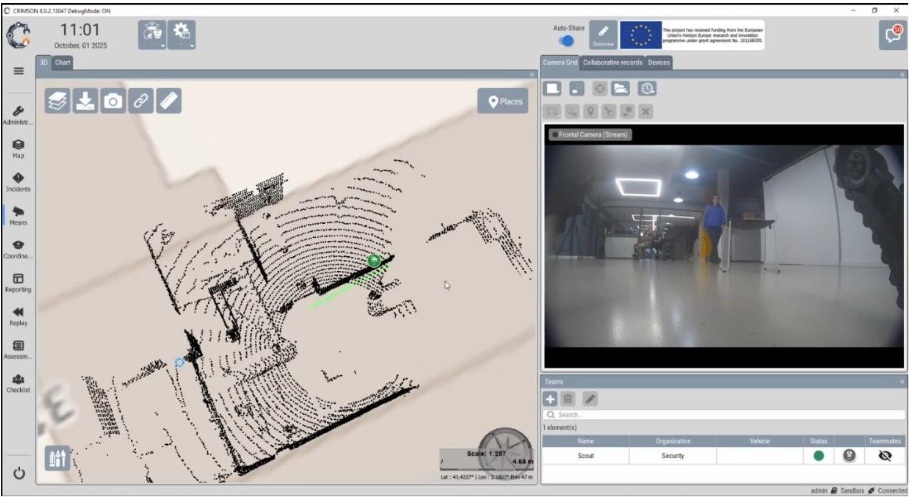A Glimpse into the Future of Crisis Management, where robots and humans work hand in hand
In challenging high-risk and low-visibility hazardous environments, every second counts to save lives and avoid risking first-responders ones. In these situations, a timely and accurate situational awareness is crucial to gain understanding of the incident and optimally handle available resources allocation, making interventions more efficient. The CARMA project brings a transformative approach to crisis management through its Command and Control (C2) system, integrated with autonomous and semi-autonomous Unmanned Ground Vehicles (UGV) platforms.
Such platforms, designed to work in collaboration with humans, allow symbiotic missions orchestration, within the C2, between a robot and first responders, as well as citizens assistance though audio channels and chatbot-like interactions.
Designed to empower first responders with enhanced situational awareness and operational efficiency, the CARMA C2 is the central system of a symbiotic human-robot platform that redefines how autonomous and semi-autonomous Unmanned Ground Vehicles (UGVs) and human teams collaborate in the field.
The CARMA C2 builds on CS GROUP’s Crimson platform, distinguished with the European Commission’s 2025 European Security Innovation Award in June 2025. This recognition highlights Crimson’s technological and operational excellence, and its impact on strengthening the European Union’s resilience against natural and man-made disasters, which continues through CARMA.
CARMA Command and Control System
The CARMA Command and Control (C2) system allows responders to share enhanced 2D/3D/4D situational awareness of the incident enriched with CARMA UGVs sensor measurements including their position and status on the map, thus providing visibility on human and robotic assets available on the field.

The C2 centralizes real-time data from sensors (RGB-D camera, thermal camera, lidar, radar, and CBRN-E) and processes it into structured, geolocated alerts and measurements. These include victim detection in video feeds, obstacle identification in 3D scans, and fire detection in thermal imagery, offering a clear and actionable overview of the incident, facilitating decision making and efficiency.
Further to this, through its integration with the robotic platforms and their sensors, the C2 is also able to display live video and audio streams from the incident site, thus enabling remote victim assistance.

More than a simple display
The CARMA C2 does more than display data from the field. Through its integration with the Symbiotic Mission Orchestration module, the C2 acts as the operational “brain” behind the missions, using AI and operational doctrine models to recommend actions and allocate resources based on mission priorities and unit capabilities. This is facilitated through the visual no-code authoring tool for defining operational doctrines tailored to specific mission contexts. is capable of orchestrating joint operations between UGVs and first responders.
Interoperability and Resilience, Built-In
To support effective collaboration, the CARMA C2 system is built on a modular architecture that integrates all CARMA components. This ensures interoperability between responders and robotic units, even under degraded network conditions. Smart resynchronization mechanisms and optimized bandwidth usage are designed to maintain system performance and data consistency in the field.

Beyond CARMA
CARMA is extending CS GROUP’s Crimson product’s capabilities to manage symbiotic missions in hazardous environments, where robots are becoming an integral part of first responder operations. Crimson’s growing interoperability with a wide range of robotic platforms strengthens its potential for future deployment, making it a scalable and adaptable solution for evolving crisis response needs beyond the project duration.
